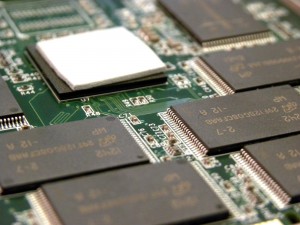
An SSD’s internal NAND chips and controller.
Failing hard drives tend to make noises (though not always, as we’ve discussed in other articles). Solid-state drives are more subtle: They may not give any indication whatsoever that they’re near the end of their operational lifespans.
The most common signs include sudden, severe performance drops, errors when trying to save files, and data that mysteriously disappears. Spotting these symptoms early can help you avoid data loss — though if we get one point across in this article, we hope that it’s this: back up your data regularly, regardless of the type of storage device you’re using.
We’ll walk you through the seven key warning signs that your SSD may be on its last legs. If you’ve lost data due to an SSD failure, we’re here to help. Call 1-800-237-4200 to schedule a risk-free evaluation or submit a case online.
1. Severe Performance Degradation
One of the most obvious signs is that your computer suddenly feels incredibly slow. You might notice your system takes minutes to boot when it used to take seconds, or applications (especially large ones) hang for long periods. A healthy SSD is fast; a failing one struggles to read or write data from dying NAND flash cells, causing system-wide lag.
Of course, computer performance can suffer for dozens of reasons, and your SSD’s health is pretty low on the list. Before you replace the drive, check for malware, too many programs running in the background (especially at startup), or insufficient RAM (memory).
2. Your Drive Becomes Read-Only
You may encounter an error message stating you can’t save a new file or that the drive is “write-protected.” Many SSDs have a built-in failsafe: when the controller detects a critical problem, it will lock the drive into a read-only mode. The goal is to prevent further data corruption, giving you a final chance to read (and back up) your data before the drive fails entirely.
3. Disappearing Files or Corrupted Data
You might go to open a file you were just working on, only to find it’s gone or your computer reports the file is corrupted and cannot be opened.
Files may disappear due to failing memory cells. The drive’s internal “map” (its table of contents) might get damaged, or the specific cells holding your file’s data may have failed. Data corruption is complex, and the safest course of action is to turn the drive off as soon as possible — don’t attempt to use data recovery software unless you’ve cloned the drive.
4. The Drive Is No Longer Detected
Your computer’s BIOS or UEFI (the low-level system that starts up before Windows or macOS) may suddenly stop “seeing” the drive. It won’t appear in Disk Management or Disk Utility, and your computer will fail to boot (assuming that the SSD is your boot drive). You might see an error message like “No Bootable Device Found.”
A sudden disappearance like this often points to a failure in the drive’s controller, which is a serious problem. It could also be an issue with your computer’s motherboard, so plugging the SSD into another machine might resolve the issue.
5. Frequent Crashes and Blue Screens
If your computer crashes frequently — especially during the boot-up sequence or when you’re accessing large files — the SSD may be struggling to locate the system files that the operating system (OS) needs to run.
A Blue Screen of Death (BSOD) on Windows or a kernel panic on macOS can be triggered when the operating system tries to read a critical system file from a bad spot on the drive and fails. Back up important data and attempt to repair the OS installation (or, failing that, replace the drive).
6. The “Bad Block” Error
Over time, the memory cells on an SSD wear out from use. That’s a normal part of their lifecycle, and it’s unavoidable — all data storage devices eventually fail.
Good drives manage memory wear by marking bad blocks and moving data to healthy ones. When a drive is failing, it may run out of spare blocks, or this background management process will fail. You’ll start seeing operating system errors about being unable to read or write to a sector or block on the drive.
7. A S.M.A.R.T. Status Warning
Most modern drives support S.M.A.R.T. (Self-Monitoring, Analysis, and Reporting Technology). Your computer can read this data to gauge the drive’s health. If you see a “S.M.A.R.T. Status BAD” or “Drive Failure Imminent” warning during startup, believe it. You can also use free utility tools to check your drive’s S.M.A.R.T. status manually.
If you recognize any of these symptoms:
- Stop Using the Drive Immediately: Continued power-on time and use, especially writing new data, can cause the drive’s internal error correction to fail, making data unrecoverable.
- Back Up Critical Data: If the drive is still visible, back up your most important files to another location (a different internal drive, an external drive, or cloud storage) right away.
- Do Not Run “Fix-it” Utilities: Avoid running disk repair utilities like chkdsk (on Windows) or First Aid (on macOS). On a physically failing drive, these tools won’t work, and they can exacerbate the damage.
Professional Solutions for SSD Data Recovery
At Datarecovery.com, we use purpose-built, proprietary systems designed to communicate directly with failed SSD controllers and read data from the individual flash chips. Our engineers have decades of experience with all major SSD brands and failure types, and we provide risk-free evaluations to determine the exact cause of failure and the chances of a successful recovery.
Contact Datarecovery.com at 1-800-237-4200 for a free consultation, or submit a case online to get started.




